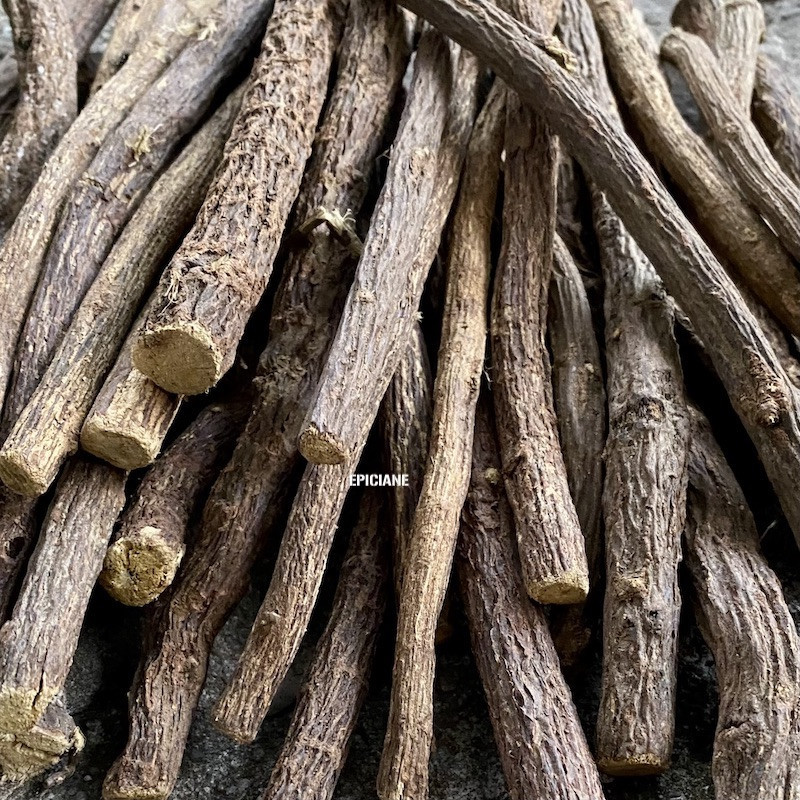- Out-of-Stock




With the taste of licorice, both sweet and slightly bitter, it brings back all the memories of childhood!
You can chew it for fun or infuse it to prepare delicious drinks.
 Delivery
Delivery
Mondial Relay
 Returns
Returns
See conditions
 Payments
Payments
100% secure
Livré en sachet refermable
°°°
Les bâtons que je vous propose font de 18 à 20cm de longueur, et leur diamètre est évidemment variable, mais en moyenne, un bâton pèse entre 10g et 15g. Il y en a donc entre 4 et 6 dans 50 gr.
Uses in Cooking and Beyond:
Here, we are offering natural, unpeeled licorice.
Licorice has a curious blend of sweetness, bitterness, and a sugary sensation all at once. Its flavor pairs well with vanilla, which softens its slight bitterness, as well as with mint, honey, caramel, and even coconut.
In stick form, like here, it is most commonly enjoyed by chewing, but some people still make a type of pastis by macerating whole sticks and other spices in alcohol with added sugar. This drink is delicious and completely natural, though it should be consumed in moderation due to its alcohol content. You can also macerate whole sticks or chopped licorice in the cooking juices of certain white meats like chicken or guinea fowl, giving these dishes an exotic twist.
Licorice can be found in many candies and an old treat familiar to some: Coco Bauer. This root is also used in pharmacopoeia and continues to be used in the production of drinks like pastis (both alcoholic and non-alcoholic).
Many people chew on licorice sticks, especially children, but also those trying to quit smoking, often unaware that they are benefiting from this powerful remedy! Chewing on a licorice stick, especially in winter, can be a great defense against respiratory infections and winter viruses.
Who am I?
Origin: Iran
Scientific name: Glycyrrhiza glabra
Common names: Licorice, sweetwood, caliche (in Belgium), reegalisse
The name "licorice" is given to both the plant and its roots, and it’s used interchangeably in masculine and feminine forms, although the plant itself is always feminine.
Licorice is a perennial herbaceous plant from the Fabaceae family, growing in bushes that reach between 1m and 1.5m in height. Its aromatic roots, which are rhizomes, are consumed. The plant has light green leaves that resemble those of acacias, and it produces small blue to violet flowers arranged in upright clusters. The fruit is a small, flat pod about 2 to 3 cm long, containing numerous seeds. It is native to southern Europe, and its harvest takes place from September to November.
The plant grows in rich, moist soils and requires a warm climate, such as those found in the Mediterranean, southern U.S., the Middle East, and North Africa, where it has long been introduced. When it thrives, licorice can become very invasive; even a single root left in the ground can sprout new growth!
Licorice is tonic, digestive, and soothing for the throat. It was widely used in the 1950s for ulcers and gastritis.
However, some of its active ingredients can raise blood pressure, cause edema, and decrease potassium levels in the body. Excessive daily consumption of licorice and products containing it can lead to serious health issues. Therefore, its use is not recommended for those with high blood pressure.
A Little History:
Licorice was already known to the ancient Greeks and Romans, who used it to clear the voice, and it seems that even the Pharaohs enjoyed it.
In the 13th century in Montpellier, a small candy called "grisette" was created by combining licorice and honey. Around the same time, licorice began being cultivated around the Mediterranean, whereas it had previously been a wild plant. Later, it was combined with roasted couch grass root to prepare a drink called "hospitalière," which was commonly found on bedside tables in hospitals.
In the 15th century, after Jacques Coeur brought gum arabic from the Orient, enabling the invention of chewing gum, licorice began flavoring these treats, which would later be called "bonbons."
By the 18th century, "coco" became a trend in Paris—a drink made from licorice macerated in lemon water, sold on every street corner. At the same time, people were consuming "cachous," a mix of licorice and areca nut, a mild stimulant.
It is said that Napoleon Bonaparte became addicted to licorice after consuming it excessively.
Data sheet
 Macire D.
Macire D.
Bravo pour votre produit de qualité

 Macire D.
Macire D.
Bravo pour votre produit de qualité

Reference: 7N7525705
Reference: 00022475-0001
Reference: SPW06600
Reference: 10N7738802
Reference: 7N7525705
Reference: 1N7004306
Reference: 3913
Reference: SPW06600
Reference: verveine
Reference: 00033929-0001
Reference: 6470
Reference: cardamomeverteE
Reference: 050721
Reference: baiepassion
Reference: 3N7137901
Reference: bergamote
Reference: ecorcecitronH
Reference: badianeM

With the taste of licorice, both sweet and slightly bitter, it brings back all the memories of childhood!
You can chew it for fun or infuse it to prepare delicious drinks.